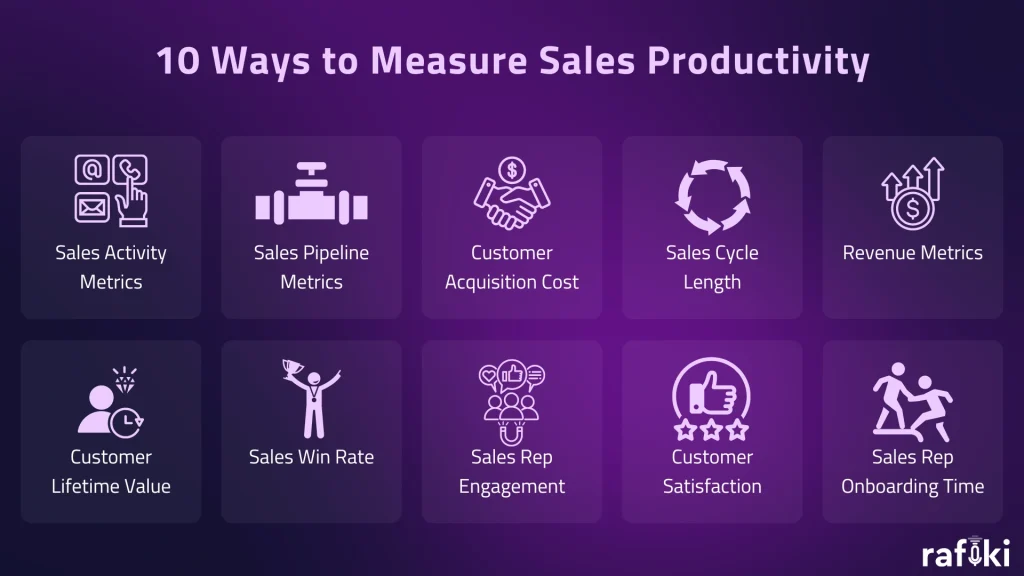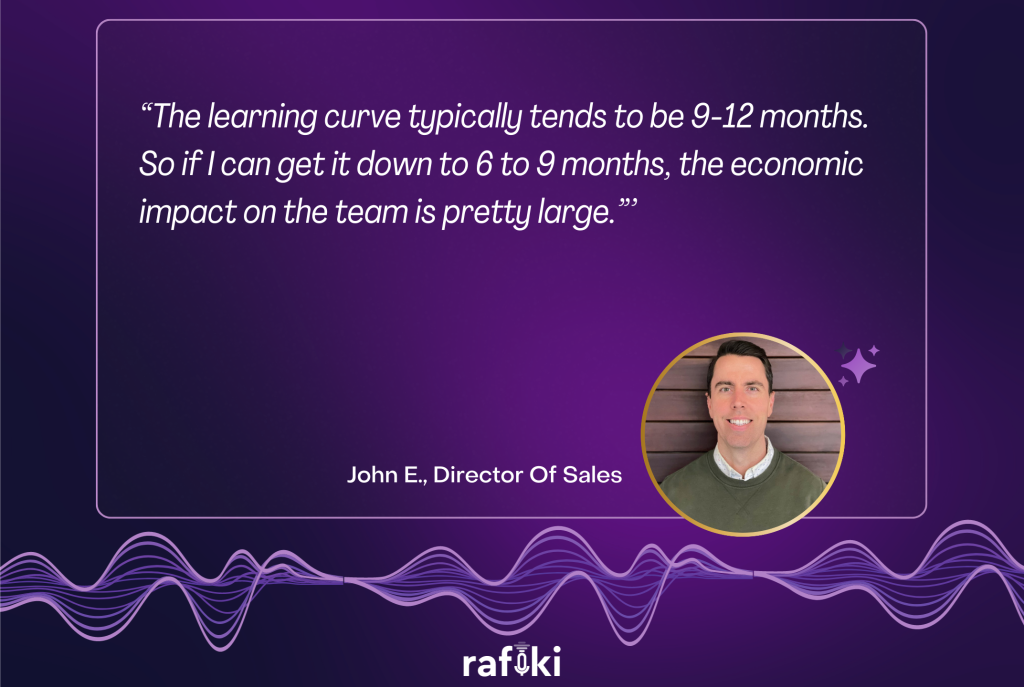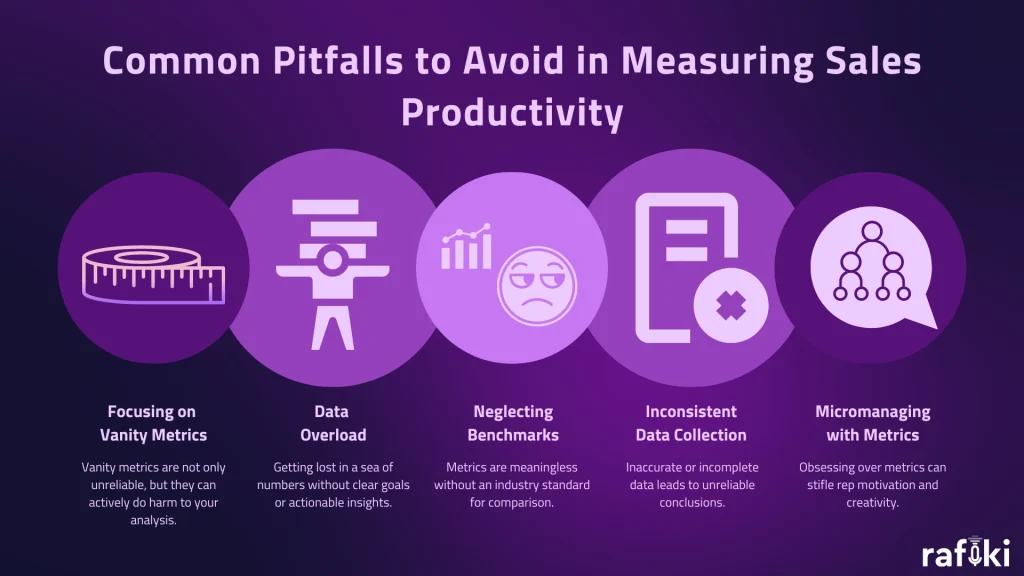Why Rafiki
Pricing


Pricing
Solutions

RevOps Leaders
Synchronize revenue generating functions

SDR Leaders
Get your team aligned and Coach your Reps 3x faster at scale

Sales Leaders
Unlock pipeline truth, drive confident forecasts

Feeling the pressure to ramp up your sales team's performance for this and next quarter? Every sales leader is perpetually in that position. Always need more. But, as you may know, in sales, optimizing productivity is the golden ticket to revenue growth. But how do you measure sales productivity beyond just the bottom line?
This guide dives deep into 10 ways to assess your sales team’s productivity from different angles giving you a richer, more robust view.
Let’s go!
Revenue numbers are undeniably crucial, but they only tell part of the story. Measuring sales productivity goes beyond just looking at past performance. It's about gaining a deeper understanding of your sales engine and identifying areas to fine-tune it for future success.
If you’re reading this, chances are you already have a strong WHY for measuring sales productivity. But it’s important to know the full picture. So, here are all the reasons for why you should measure sales productivity:

This method tracks the sheer volume of prospecting activity. Monitor the number of calls made, emails sent, and meetings booked by each rep.
A high volume of activity indicates hustle, but Rafiki's Smart CRM Sync can ensure these activities translate into qualified leads by capturing key details from calls and auto-populating your CRM. What this means is that non-selling activities that don’t count towards sales productivity get automated.
Thus, your reps are able to do more selling activities furthering their productivity.
Average Calls per Rep per Day = Total Calls / (Number of Reps x Number of Work Days)
*Similarly for emails sent, meetings booked etc.
A healthy pipeline is the lifeblood of future sales. Track the number of opportunities created, the total value of your pipeline, and the conversion rates at each stage of the sales funnel. This reveals where deals get stuck and identifies opportunities for streamlining your sales process. The most important metric when it comes to pipelines is the conversion rate.
Sales Pipeline Conversion Rate (%) = (Number of Deals Closed Won / Number of Opportunities Created) x 100
This metric reveals the true cost of acquiring a new customer. Divide your total sales and marketing expenses by the number of customers acquired in a specific period. A high CAC might indicate inefficient sales efforts. Look for ways to optimize your prospecting strategy and improve lead quality, both of which are factors that affect sales productivity.
Customer Acquisition Cost (CAC) = Total Sales & Marketing Expenses / Number of Customers Acquired
This metric measures the average time it takes to close a deal. Track the time from initial contact to signed contract. A lengthy sales cycle might indicate complex deals, ineffective communication, or slow approvals. Rafiki's Smart Follow Up can help expedite this process by automatically crafting personalized follow-up emails after each call, keeping deals moving forward.
Average Sales Cycle Length (Days) = Total Deal Close Times (in Days) / Number of Deals Closed Won
These are the classic sales productivity indicators. After all, better bottom line numbers must mean better productivity, right? This metric only provides a high-level view and doesn’t give you specific information, but still good to keep an eye on. Track total revenue generated, average deal size, and win rates. They provide a high-level view of your team's overall effectiveness in generating sales.
Average Deal Size = Total Revenue / Number of Deals Closed Won
*There are several other revenue metrics, the above is an example.
Look beyond immediate sales and consider the long-term value of your customers. Calculate the total revenue a customer generates over their entire relationship with your company. This metric helps assess the effectiveness of your sales efforts in acquiring high-value customers. If your reps are able to prioritize accounts that would have high CLTV, that should be accounted for when looking at sales productivity. This is one of the ways in which your reps can work smarter and not just harder.
Customer Lifetime Value (CLTV) = Average Revenue per Customer x Average Customer Lifespan
This metric reveals the percentage of opportunities that convert into sales. Divide the number of deals closed won by the total number of opportunities created. A low win rate might indicate issues with qualification, presentation skills, or pricing strategy.
Sales Win Rate (%) = (Number of Deals Closed Won / Number of Opportunities Created) x 100
A highly engaged sales rep is a productive one. Track activity within your CRM, participation in coaching sessions, and feedback surveys. Low engagement might signify a lack of motivation, unclear goals, or insufficient training. It’s a bit of an indirect way of calculating productivity, but only because the impact of this is invisible, not because it’s non-existent.
Sales Rep Engagement Score (Customizable): Assign points for desired activities (e.g., CRM updates, coaching attendance) and calculate an average score for each rep.
Happy customers are loyal customers. Use surveys and tools like Net Promoter Score (NPS) to measure customer satisfaction after the sale. High satisfaction indicates effective sales interactions and a strong foundation for long-term relationships. Similar to CLTV calculation, you’re accounting the quality of reps’ work into their productivity calculation.
Net Promoter Score (NPS) = % Promoters (Score 9-10) - % Detractors (Score 0-6)
The faster new reps become productive, the sooner they contribute to the bottom line. Track the time it takes for new reps to reach specific performance benchmarks. A lengthy onboarding process might indicate a need for improved training materials or mentorship programs.
Average Sales Rep Onboarding Time (Days) = Total Onboarding Time for New Reps / Number of New Hires
With Rafiki, ReferralMD was able to cut down rep ramp time by 30%+. Here’s what they said:

Equipping yourself with the right tools is crucial for maximizing the effectiveness of your sales productivity measurement efforts. Here's where a robust CRM system comes in. CRMs like Salesforce or HubSpot centralizes all your sales data, from activity levels to deal progress, making it easy to track key metrics and generate reports. A significant portion of the data you require to calculate sales productivity can be obtained from your CRM, if you dig deep enough (or ask your CRM operations team!).
Beyond the CRM, consider sales analytics tools that offer deeper insights. These tools can analyze call recordings (think Rafiki's Smart Call Scoring!), identify sales trends, and even predict future performance. With the right data at your fingertips, you can make data-driven decisions to optimize your sales strategy and boost your team's effectiveness.
If your team uses dialers like Aircall or Twilio you can find the call metrics from there, whereas outreach tools such as Mailchimp or MailerLite, if you use them, will have the relevant email metrics. Now referring to each tool one by one can be a lot of back and forth. So, it’s best to use these tools’ integrations or Zapier to funnel relevant data into your CRM and create a dashboard there. Makes it easy to keep a watchful eye on your team’s productivity.
Now before you get started on implementing measurement, here’s a quick reminder on what to be aware of:

Measuring sales productivity isn't a one-time sprint; it's an ongoing marathon. By consistently monitoring key metrics and adapting your approach, you can continuously refine your sales engine.
Measure and Boost Sales Productivity
Keep in mind, the goal isn't just to track numbers; it's to use data-driven insights to empower your reps, optimize your sales process, and ultimately, drive sustainable revenue growth for your business.
Explore how Rafiki can help cut down on your reps’ wasted hours on non-selling activities and skyrocket their productivity by signing up for a free 14 day trial!